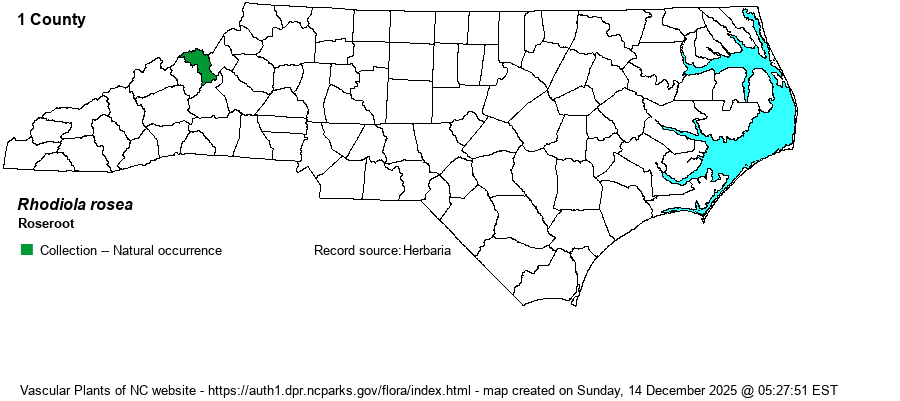| Author | L. | |
| Distribution | Known for certain (collections) only at the Roan High Bluff (also known historically as "Lyons Bluff") portion of Roan Mountain massif, in Mitchell County. Collections and reports elsewhere -- from Ashe County to Avery County -- almost certainly refer to Hylotelephium telephioides (a native species also or rocky places) or to some other member of Crassulaceae, perhaps even a non-native species.
This is a Boreal and Arctic-Alpine species of eastern Canada, south only to NY and PA, and then highly disjunct to a single peak in western NC.
| |
| Abundance | Formerly known for certain only from Roan Mountain, apparently last seen in 1981. However, this site has been searched for in recent years and the species has gone missing. Its disappearance was certainly due in part to over-collecting of this tiny and localized population, and probably also to a documented localized landslide. The NCNHP has assigned a State Rank of SH. This is a State Endangered species. | |
| Habitat | This species grew only in high elevation rocky summits, near the top of a peak. The plants grow/grew in thin soil in crevices and cracks in rocks, often where near vertical. |
| Phenology | Blooms in July and August, and fruits in August and September. | |
| Identification | This is a very fleshy herb, often with several stems from the base, growing to about 8-10 inches tall. The thick, glaucous leaves are alternate but very crowded along the stem, sessile, generally elliptical in shape, about 1-1.5 inches long and 3/4-inch wide, and entire to slightly toothed toward the apex. The many leaves all tend to be about the same size, from the base to the top of the plant. The flower cluster at the top of the stem is very dense and only about 1 inch wide, with the many individual flowers being greenish-yellow in color, then turning purple in age. In bloom, it should not be confused with other species. However, when not in bloom, it can be confused with the generally more robust Hylotelephium telephioides. Weakley (2018) states that "Dwarfed, high elevation forms of Hylotelephium telephioides, with narrow, nearly toothless leaves, have been confused with Rhodiola rosea; they are perhaps readily distinguished only in flower or fruit." | |
| Taxonomic Comments | Formerly named as Sedum rosea.
| |
| Other Common Name(s) | None | |
| State Rank | SH | |
| Global Rank | G5 | |
| State Status | E | |
| US Status | | |
| USACE-agcp | FACU link |
| USACE-emp | FACU link |

